SAP, One of the World’s Largest Tech Companies, Aims to Tackle Scope 3 Emissions


Companies are increasingly being regulated to lower their greenhouse gas emissions and produce net-zero strategies. In some cases, reducing emissions is relatively straightforward. Once you start diving into what achieving net zero actually entails, however, the waters can get pretty murky. In response, one of the global leaders in business software and technology, SAP, is stepping up to help companies reach their ambitious climate action goals.
The complexities, for the most part, involve Scope 3 emissions. Scope 1 emissions are those created from direct business activities and Scope 2 covers the emissions from the generated electricity, steam, heating and cooling functions associated with the business. Scope 3 emissions, which account for the vast majority of emissions in most companies, cover those created across entire value chain of an organization — all the way upstream to the raw materials, and all the way downstream to consumer end use and disposal.
Multinational corporations with hundreds or thousands of suppliers around the world run into significant challenges when trying to track, measure and report their Scope 3 emissions. These challenges aren’t insurmountable, but they do require strong relationship-building with suppliers and support from digital technologies.
Global technology company SAP is uniquely positioned to help companies with their Scope 3 emissions. Having almost 90 percent of the world’s financial and goods flows touch an SAP system, including nearly all carbon flows, SAP has access to the supply chain data that companies are looking for in their Scope 3 accounting. SAP is converting this unique position into sustainability solutions that ease the hurdles that businesses encounter when trying to manage these challenging emissions.
What are the challenges with assessing Scope 3 emissions?
We can break down the main challenges associated with Scope 3 emissions into three categories: understanding what and where to report, collecting emissions data, and organizing and using the data. Each phase of the process presents its own set of difficulties.
Understanding what and where to report. For organizations new to Scope 3 reporting, the first step is figuring out what they need to report. Identifying which jurisdictions and reporting frameworks require Scope 3 disclosures, understanding the different requirements of each disclosure, and identifying which emissions are most material to the organization are three of the most significant challenges in this phase.
The International Sustainability Standards Board standards, set to take effect in 2024, are expected to become the global standard for sustainability reporting and should finally bring some clarity to the regulation migraine. Most jurisdictions are expected to adopt this standard moving forward. But as of right now, the lack of uniformity across frameworks and across jurisdictions is one of the most frustrating aspects of Scope 3 reporting for organizations.
“When I speak to C-level executives, the problem is the lack of standardization and the insecurity about accurately measuring and baking sustainability into business cases,” says Sebastian Steinhaeuser, chief strategy officer at SAP.
Collecting Scope 3 emissions data. The next phase is collecting data, and this is where things can get quite complicated. The main challenges with collecting emissions data are identifying all suppliers, getting accurate primary data, finding secondary data or industry averages when primary data is unavailable, and managing industry-specific issues.
Sifting through extensive supply chains to identify all suppliers and find the required emissions data is an incredibly painstaking task. For companies that have thousands of suppliers all over the world, this might be nearly impossible, and at best, it’s immensely time-consuming.
SAP’s Sustainability Data Exchange allows companies and suppliers to effectively share standardized emissions data across business networks. Meanwhile its Sustainability Footprint Management solution calculates and manages the entire range of value chain emissions, producing audit-level data that is ready for use in the various reporting frameworks.
Whether trying to tackle this problem on your own or by employing a data management system like SAP’s, the most important thing is to build strong relationships with suppliers. It’s critical that suppliers understand the importance of their role and the benefits they enjoy by providing accurate, granular emissions data.
Organizing and using Scope 3 emissions data. Companies that employ a carbon emissions data management system can make great strides in managing their Scope 3 emissions data. Receiving data in many locations and compiling it all in one place, avoiding critical errors in manual data collection, receiving data at different timeframes from suppliers, and having to manage data submitted in different formats can all provide substantial headaches for sustainability teams.
Beyond collecting and organizing critical emissions data, the key is to use the information to optimize and ultimately reduce emissions.
"Technology gives business leaders the needed data transparency to make more sustainable business decisions,” Steinhaeuser says. “Having the ability to work with verifiable data across supply chains will change the way business works and accelerate climate action.”
With significant penalties on the rise for non-compliance and greenwashing, companies need to be sure the data they report is 100 percent accurate. Any errors or oversights in this phase can spell disaster for a company’s regulatory compliance and public image.
Having a trusted emissions data management program will not only hugely reduce a company’s workload, but it will also give them the peace of mind that the data they are reporting is auditable, accurate and complete.
The SAP transactional carbon accounting approach
To effectively reduce emissions, companies need to work with the most accurate data available. However, not all suppliers are able to provide such data yet. This is where a transactional carbon accounting can help companies get the most accurate snapshot of their emissions profile and drive change by leveraging their financial management systems.
“Only 9 percent of companies have a comprehensive view of their greenhouse gas emissions and their impact across the entire value chain,” Steinhaeuser says. “We need to account for carbon with much more precision and control by using actual data values across our business operations and supply chains in sync with financial flows.”
Incorporating a hybrid strategy allows companies to focus first on the areas of their supply chain that produce the most emissions, work to reduce those emissions, and then transition to a broader scope of the supply chain, incorporating more supplier-contributed primary data.
With all of the complexities and challenges involved with Scope 3 emissions, taking a targeted approach that slowly builds the wealth of primary data will allow for continued improvement and greater accuracy in a company’s Scope 3 profile. This approach will not only satisfy regulators, but it will also provide investors and other stakeholders with confidence that businesses understand where their emissions are coming from, and that they are doing all they can to reduce them, one step at a time.
This article series is sponsored by SAP and produced by the TriplePundit editorial team.
Image credit: NASA/Unsplash
With Agrivoltaics, Farmers Can Harvest Food and Energy Together: So, How Does It Work?


Lightstar Renewables' community solar project in Saugerties, New York, generates enough energy to power 770 homes and offset 5,192 tons of carbon dioxide per year.
Recurrent, record-setting temperatures make one thing clear: The climate crisis is upon us. With the phenomenon no longer in the future tense, the dialogue is starting to shift. Prevention can no longer be our sole focus. We must also begin to adapt. Agrivoltaics presents a promising way to do so, while cutting greenhouse gas emissions through renewable energy production.
Agrivoltaics is dual-use solar
So, what are agrivoltaics? “It's a single parcel of land being used for both solar and either agricultural or horticultural productivity,” said Kelly Buchanan, policy and strategy manager at Lightstar Renewables, a community solar developer that is expanding into agrivoltaics.
Solar panels can be installed above crops on a farm, for example. They can also be mounted over greenhouses or above pastures to provide shade for livestock. Meanwhile, the energy produced can be made available to the surrounding community through local utility subscriptions. Or, if farmers and landowners install their own panels, they can use the electricity generated to mitigate their energy costs.
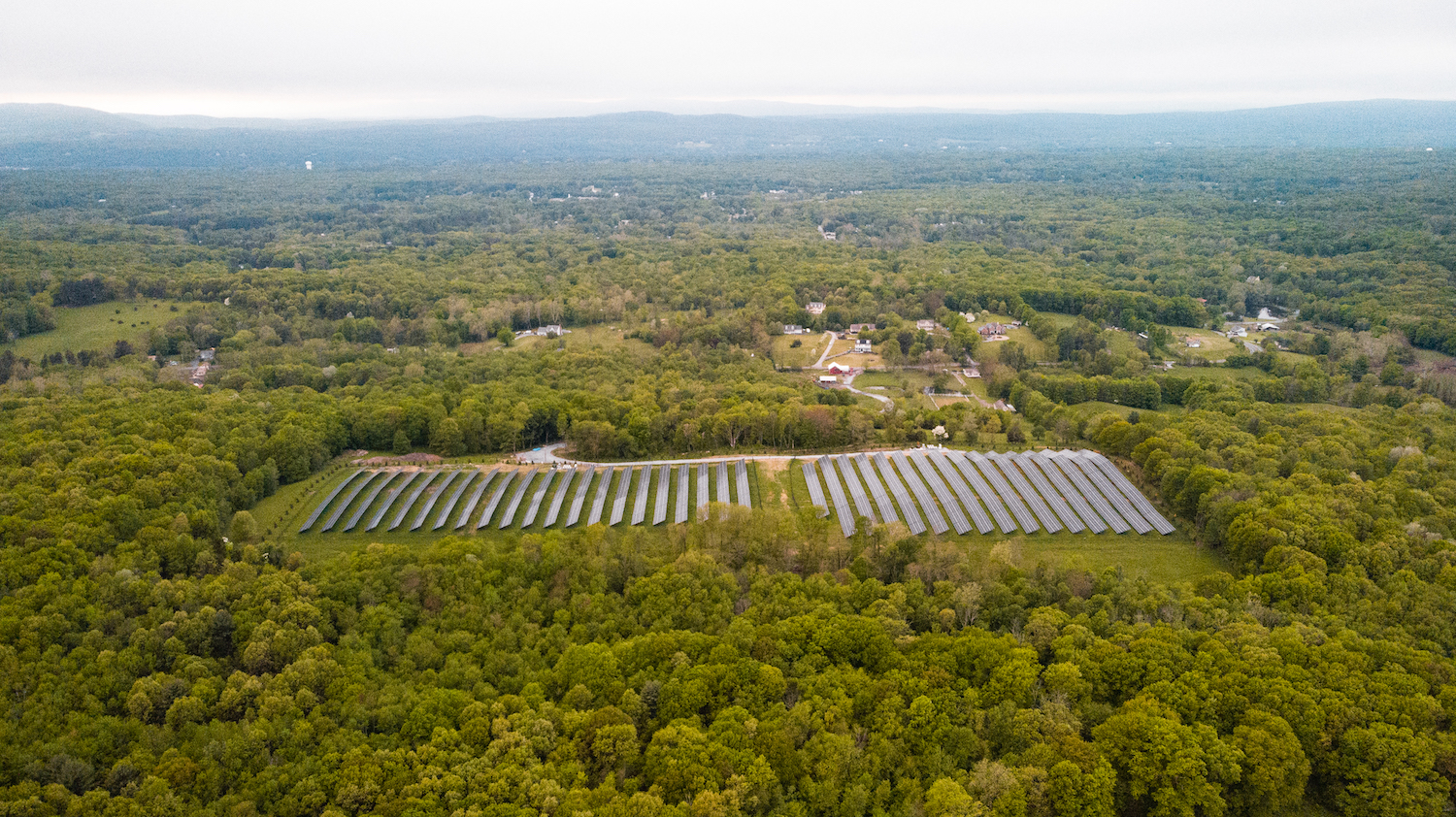
Designed to optimize sunlight and shield crops
Although it may look like the solar panels block out the sun and limit photosynthesis, this is not the case. “The solar panels tilt," Buchanan explained. Each panel sits on a single axis tracker that follows the sun throughout the day, optimizing solar power generation and providing the plants underneath with plenty of light. The solar panels are also bifacial, meaning they can generate energy from sunlight on both sides.
Not only do agrivoltaics double up on land use by allowing solar energy production on the same soil that grows food, but the practice also offers an important adaptation option for our warming planet. Solar panels that are mounted above crops have a protective effect, keeping plants cooler and leading to less evaporation and, therefore, less demand for irrigation, Buchanan explained. Water that does evaporate helps cool down the solar panels to optimize energy production.
“[With] the drought out West and the increasing pressure on what we use our water for, it’s huge," Buchanan said. “There's another benefit here of the solar panels creating a bit of a microclimate which can shelter from heavy rain events [and] protect plants from hail."
Increased yields
With all of these benefits, it’s no surprise that many crops actually perform better under the cover of solar panels than they do when they are completely exposed to the elements.
“In Arizona, for example, we saw that tomatoes fruited more, and peppers produced up to three times more underneath these projects," Buchanan said. "We also saw, out of a study coming from Massachusetts, that peppers, broccoli, kale and Swiss chard all saw the same or greater yield, despite a record dry and hot summer in the year the study was conducted. There's a huge opportunity here."
Benefits for farmers and landowners
In addition to the potential for higher yields and lower water needs, farmers and landowners can benefit financially from agrivoltaic contracts. “The landowner gets a lease payment for the use of the land monthly,” Buchanan said. Farmers also receive stipends to reimburse them for their time spent cutting weeds and vegetation away from the panels.
“From the start of the project to the end, our priority is to work with farmers and farm managers to understand how agrivoltaics can be implemented and the system that works best for them,” she said. “And we're really taking into consideration soil health, especially in the construction period, and making sure we retain that soil.”

Drawbacks and challenges
While the research is encouraging, not all crops have been tested for compatibility with agrivoltaics. For all we know, some may fare worse under the system, though this does not appear to be the case so far.
Still, since the concept of agrivoltaics is in its infancy, it will likely be a while before these systems are implemented at scale. “It takes a lot of time to bring this new idea to communities, to answer their questions, to make sure they're getting the information they need, and then to allow the stakeholder process to unfold and allow communities to coalesce from a regulatory standpoint,” Buchanan said. Communities may need to vote on new zoning ordinances, for example, to allow agrivoltaics projects to go forward.
It’s too early to say whether agrivoltaics can solve the competition for land between crop farms and solar farms. But the data suggests there are big benefits to marrying the two together — especially as the climate crisis worsens and the need to adapt, while also lowering dependence on fossil fuels, becomes an absolute necessity.
Images courtesy of Lightstar Renewables
Skilled Trades Are in Demand: So, Why Aren't More Young People Getting Into Them?


A student trains in 3D modeling and design, one of many skilled building trades in high demand in the U.S. (Image courtesy of Mississippi Gulf Coast Community College)
The demand for skilled trades like carpentry, plumbing and electrical is booming across the United States. The construction sector alone will need to draw nearly 550,000 new entrants into the field to meet the demand for labor this year, according to Associated Builders and Contractors, an industry trade group.
Not only do these jobs pay well, but people also say they enjoy doing them: Construction jobs rank second highest in levels of self-reported happiness and second lowest in levels of self-reported stress, according to 2022 polling from the U.S. Bureau of Labor Statistics. Still, employers are struggling to fill vacant roles, and it's set to get harder in the coming years as baby boomers and Gen Xers near retirement.
"If you look at the average age of somebody in the skilled trades, a majority of these people will be retiring within the next 10 years," said Jordan Sanderson, an associate vice president at Mississippi Gulf Coast Community College, which serves more than 8,500 students a year across nine locations in the southern part of the state.
The Lowe's Foundation, the nonprofit arm of the home improvement retailer Lowe's, is looking to change that by attracting and training up more young people. The $50 million Lowe's Foundation Gable Grants program, launched in March, will provide two-year grants for workforce training programs with the goal of channeling 50,000 people into skilled building trades over the next five years.
The Foundation announced its first round of grants, totaling $8 million, last week — with recipients including community and technical colleges like Mississippi Gulf Coast, as well as MiraCosta College in California, Madisonville Community College in Kentucky, and Columbus Technical College in Georgia.
“These colleges are deeply embedded in the communities they serve and are so well-positioned to meet the changing needs of the skilled trades industry,” said Betsy Conway, director of the Lowe’s Foundation. “As our first wave of many Gable Grants recipients, we’re extremely confident in their innovative training programs and ability to continue building the sustainable and inclusive workforce that our country needs.”
So, what's causing the labor shortage in skilled trades anyway?
"Back 30 some odd years ago, when I was in high school, the pressure was on for everybody to get out and go get you a college education, get you an office job," said Obey Parker, a skilled craftsman and building trades instructor at Mississippi Gulf Coast. "The computer revolution was taking off, and everybody was doing that. And vocational programs suffered as a result. They started getting put out to pasture."
As the cultural zeitgeist shifted, young people put less stock behind working with their hands and looked toward four-year college degrees for the promise of higher pay. The result? Student debt exploded more than sevenfold since the 1990s, but research shows college graduates still find it challenging to secure jobs in their chosen field.
The booming demand in skilled trades — where salaries often exceed median U.S. worker pay by 30 percent or more — offers a promising new avenue for young people in search of steady work. But getting them interested requires a shift in mindset.
"We as a society haven't done a good job over the last 10 or 20 years of promoting skilled trades," said Sanderson of Mississippi Gulf Coast. "You have these two factors of a somewhat negative perception of the skilled trades, coupled with ever-rising demand, and it creates a pretty profound worker shortage."
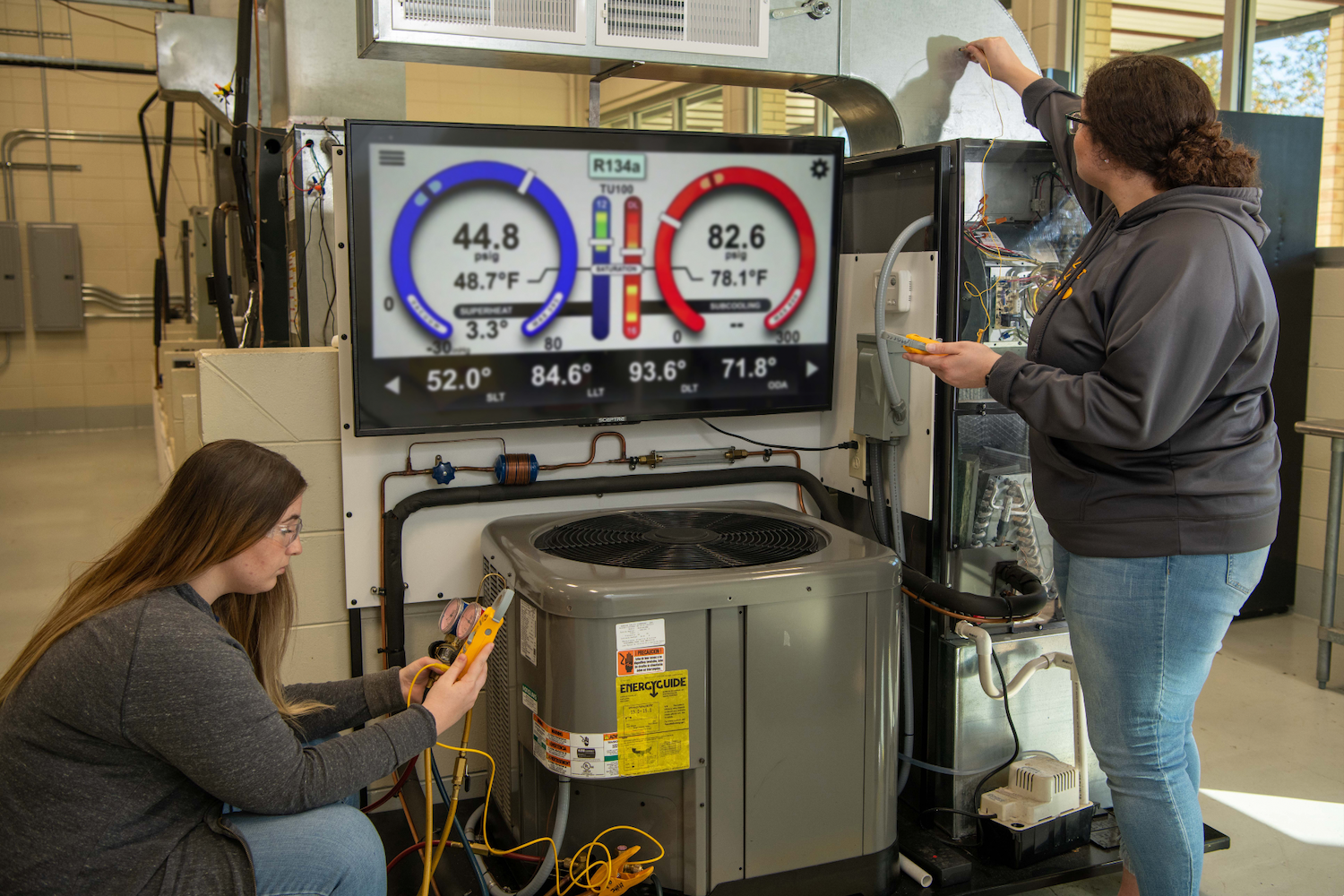
With an eye toward local job markets, community and technical colleges look to get more people involved
Interest in this space is slowly rising: 19 percent of high-school students said they are considering career and technical education in the skilled trades this year, compared to 15 percent in 2020, according to surveys from the nonprofit ECMC Group.
Mississippi Gulf Coast plans to use its Gable Grant to fund internships and apprenticeships within its skilled trades programs, so students can earn a living wage while being trained in the field, as well as scholarships for lower-income students.
Where four-year college graduates are often slow to land their first job, the majority of Mississippi Gulf Coast's skilled trades programs — which range from building trades and construction engineering to 3D modeling and design — have job placement rates above 90 percent, Sanderson said. Graduates have a near 100 percent pass rate on the exams required for industry credentials.
Given the high success rate of these programs, the college is looking to extend them to another population: those looking to rebuild their lives after leaving prison. Powered by Gable Grant funding, this year Mississippi Gulf Coast will launch a new skilled trades program at George County Regional Correctional Facility, located about 40 miles west of its main campus in a rural stretch near the Mississippi-Alabama border.
Parker will head up training at George County across skilled trades like carpentry, electrical, masonry and plumbing. "It costs in the neighborhood of a million dollars to start a new career tech program because you have to buy so much equipment," Sanderson said. "While we've wanted to do something at George County for a while, we didn't have the money to do it. The Gable Grant will help us to stand up the program."
Though mass incarceration has created a situation where around 1 in 3 U.S. adults now has a criminal record that would appear on a routine background screening, people often have trouble securing a job after they're released from jail or prison. Embracing this population can help fields like construction address labor shortages, and employers in Mississippi seem ready to do just that.
"Market research went into it to see what exactly people can get jobs in when they're released," Sanderson said. "We don't want to teach somebody how to do something and they have to move away to get a job, or they can't get the job because they have a record."
Mississippi allows inmates to transfer facilities in order to participate in workforce training programs. Those interested in entering the skilled trades can request a transfer to George County, while another nearby correctional facility offers a similar program for aspiring commercial truck drivers. Though the grant period is two years, the equipment installed at George County will allow Mississippi Gulf Coast to continue the program for many years to come.
Meanwhile, MiraCosta College, which serves more than 10,000 students at two campuses in San Diego County, California, will leverage its Gable Grant funding to start two new skilled trades programs in the in-demand fields of heating, ventilation and cooling (HVAC), as well as electrical.
"Both programs would be low cost to increase the participation of low-income individuals," said Linda Kurokawa, director of community education and workforce development at MiraCosta College. "During the two years of the grant, we expect to be able to provide training for a minimum of 168 students. Our close relationships with industry partners allow us to plan internship possibilities for students once they graduate from our programs."

It doesn't stop there
Funding for community and technical colleges is a promising way to build a strong and steady pipeline of people entering skilled trades, but it's not enough on its own.
"It needs to start in the grade schools. It needs to start early," said Parker, who often encounters students who lack the foundational math skills to start their training in building trades. He identifies stronger students to act as tutors in order to navigate this challenge, but a greater emphasis on foundational skills in early education will allow teachers to do more once students enter college. Mississippi recently invested in high-school career coaches with this aim in mind.
Beyond the requisite skills, though, educators, business leaders and everyday people need to do more to shift the perception around skilled trades and position them as viable, respected careers among the next generation.
"It is important to also make sure people understand that careers in skilled trades are stable and well-paying opportunities," said Kurokawa of MiraCosta College. "Marketing all of these aspects is crucial in attracting more individuals to these great career pathways. It also helps to accelerate the training so that individuals can learn quickly and find themselves with paid on-the-job training as soon as possible."
Inflation Reduction Act Sparks Clean Energy Manufacturing Boom, But Where are the Workers?

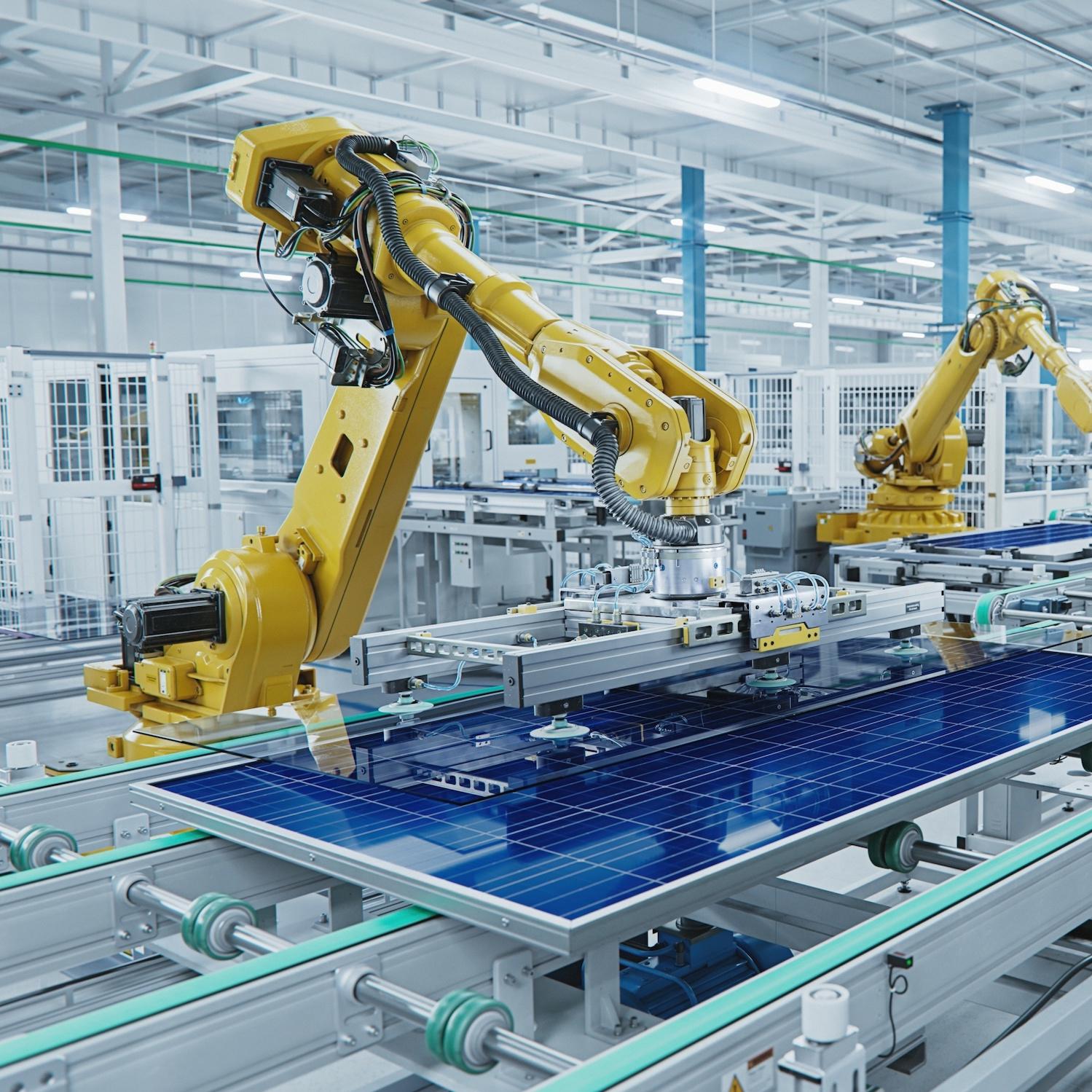
Solar panel manufacturing is just one sector that's poised for growth following passage of the U.S. Inflation Reduction Act. (Image credit: IM Imagery/Adobe Stock)
The 2022 Inflation Reduction Act will reach the one-year mark on August 16, with a stunning impact on manufacturing jobs in tow. However, a worker shortage still looms overhead. To grow the factory workforce, manufacturers must appeal to an increasingly diverse population, which challenges them to push back against legislative attacks on diversity and inclusion.
The manufacturing sector's struggles gave us MAGA, but reality doesn't match the rhetoric
In just one year, the Inflation Reduction Act has accomplished the seemingly impossible job of growing the U.S. manufacturing sector.
Factory jobs in the U.S. hit a 40-year downward spiral after peaking in 1979. Two million manufacturing jobs disappeared between 1980 and 2000. Another 5.5 million jobs were lost from 2000 to 2017.
Though manufacturing output actually continued to grow during this period, the shrinking number of people at work on the factory floor set the stage for former U.S. President Donald Trump's “Make America Great Again” campaign slogan. His message, amplified by right-wing media and punditry, conflated the loss of factory jobs with an existential threat to white, working-class men and their communities.
The race-based MAGA message also helped candidate Trump gain financial support from conservative donors. Despite the rhetoric, though, the actual “working class” — defined by households without a four-year college degree — is quickly diversifying.
In an April report, the Center for American Progress described how the MAGA focus on white factory workers glosses over actual working-class demographics.
“Throughout the 2016 and 2020 election cycles, the term became, in some circles, nearly synonymous with white workers in manufacturing or skilled trades. In fact, today’s working class is more diverse than ever,” the report reads. "Black, Hispanic, and other workers of color make up 45 percent of the working class." Women make up almost half.
Diversity in the working class is driven by the rise of employment in service industries, especially retail, health care, food service and accommodation, and building services, Center for American Progress and other analysts report.
In a 2020 report, the U.S. Bureau of Labor Statistics underscored the bigger picture of working-class diversity: “Manufacturing’s falling share of employment coincided with job growth in service-providing industries, including professional and business services, education and health services, and leisure and hospitality."
The Inflation Reduction Act and a new day for factory jobs
When manufacturing jobs peaked in 1979, they accounted for 22 percent of total non-farm employment in the U.S., according to the Bureau of Labor Statistics. By 2019, the share of manufacturing jobs fell to just to just 9 percent.
It remains to be seen if the Inflation Reduction Act can bring the sector's share of the job market closer to its former glory. However, the number of manufacturing jobs is clearly growing — and many of them are in clean energy.
By May 2023, the strategic communications firm Climate Power counted more than 142,000 clean energy jobs created by the Inflation Reduction Act, spread among 191 projects.
The sustainable business organization E2 is also tracking clean energy jobs. With an exclusive focus on private-sector investments, E2 reported on 16 major clean energy projects that were announced in July alone. E2 received data on 14 of those projects, and the total came to nearly 3,600 jobs and $2.2 billion in new investments.
“Since the Inflation Reduction Act (IRA) took effect in August 2022, businesses have announced at least 205 major new clean energy projects across 38 states," E2 wrote in an announcement last week. "Of the projects with publicly available estimates, $86 billion in new private capital would be invested and nearly 70,000 jobs created." The list is available on its website.
The factory doors are open, but where are the workers?
Announcing a new factory is one thing. Filling the factory floor is quite another. In 2021, the National Association of Manufacturers commissioned a workforce study that outlined a growing shortfall in skilled labor. “The manufacturing skills gap in the U.S. could result in 2.1 million unfilled jobs by 2030,” the trade group warned.
Competition for workers from non-factory clean energy stakeholders is another factor working against manufacturers. Energy policies during the Barack Obama administration resulted in skyrocketing growth in the areas of solar panel installation and wind farm construction, among other sectors. Some of these out-of-factory industries already have experience in recruiting clean energy workers including veterans, women and historically underserved communities.
What’s a clean energy manufacturer to do?
To attract skilled workers, clean energy manufacturers can start by implementing diversity, equity and inclusion (DEI) programs. When done correctly, DEI programming has a proven track record in helping companies to recruit women in non-traditional fields, bring more people of color into teams and leadership roles, and make the workplace more supportive and welcoming for those in the LGBTQ+ community.
However, the in-house approach to DEI is no longer sufficient. In the run-up to the 2020 election, former President Trump deployed his rhetorical firepower against diversity training, adding fuel to an ongoing wave of anti-abortion and anti-LGBTQ+ legislation. The violent tenor of the legislation is reflected in violence on social media and anti-LGBTQ+ violence on the streets, as recently illustrated by actions against AB InBev’s Bud Light brand and the retailer Target.
Against this backdrop, manufacturers need to look beyond workplace DEI programs, and the 2024 elections are a good place to start. To the extent that clean energy candidates are synonymous with human rights candidates — and they are, for the most part — clean energy manufactures can help ensure that an informed, active electorate turns out to support the rights of women, people of color and LGBTQ+ people.
As organizations like Time to Vote, HeadCount and BallotReady look to encourage voter participation, they rely on corporate partnerships to help spread the word. Companies like manufacturers also hold the influence to steer powerful trade organizations like the U.S. Chamber of Commerce and the National Association of Manufacturers to support human rights and climate action candidates.
The U.S. manufacturing sector has finally turned a 40-year-old corner. To make sure it doesn’t drop off a cliff, manufacturers need to prioritize diversity and inclusion beyond the factory gates.
Uzbekistan’s Journey to Better Cotton Production Continues


People harvest cotton in a field in Uzbekistan where sustainable cotton farming practices continue to advance.
As the summer months wane, Uzbekistan’s steppes and valleys approach a critical season for the country’s economy, history and culture: the fall cotton harvest. The central Asian nation once accounted for over two-thirds of the Soviet Union’s cotton production. It's still a top global producer of the cash crop, nicknamed oq oltin — which means "white gold" in Uzbek.
Over the course of a century, the country’s cotton sector has undergone dramatic surges, lows and redirections. After Uzbekistan’s independence and under its first president Islam Kerimov’s dictatorship until 2016, the state continued to control cotton production. Nearly 2 million citizens, including children and adults from primarily rural areas, were required to leave school and work to harvest cotton each year for meager or no pay. In 2009, civil activists launched a petition to call on corporations and government entities to boycott Uzbek cotton due to its use of government-mandated labor.
After decades of international, corporate and citizen pressure to reform its labor laws, Uzbekistan is making real improvements. Among the latest developments: In June, key stakeholders and government officials signed on to a sustainability roadmap in partnership with the Better Cotton Initiative (BCI), a nonprofit that works to improve cotton farming practices. The initiative has worked in 26 countries so far, and more than 20 percent of the global cotton supply now meets the Better Cotton standards for environmentally, socially and economically sustainable production.
Over a decade of change in Uzbekistan's cotton industry
BCI launched the Better Cotton Program in Uzbekistan in 2022, a year that marked a major inflection point in the complicated history of Uzbek cotton production.
In 2010, a year after the boycott petition, a human rights watchdog called the Cotton Campaign released a corporate pledge for brands moving away from sourcing Uzbek cotton. Hundreds of global companies, including Adidas, Disney and Macy's, signed it.
The Uzbek Forum for Human Rights — then called the Uzbek-German Forum — also began monitoring and publishing annual reports of cotton farming practices in 2010. Its 2022 report “found no evidence of systematic, government-imposed forced labor for the second consecutive year." The International Labor Organization came to the same conclusion in a report based on 11,000 interviews with farmers.
The Cotton Campaign's corporate pledge subsequently ended in March 2022, reopening the country’s cotton exports to much of the Western market.
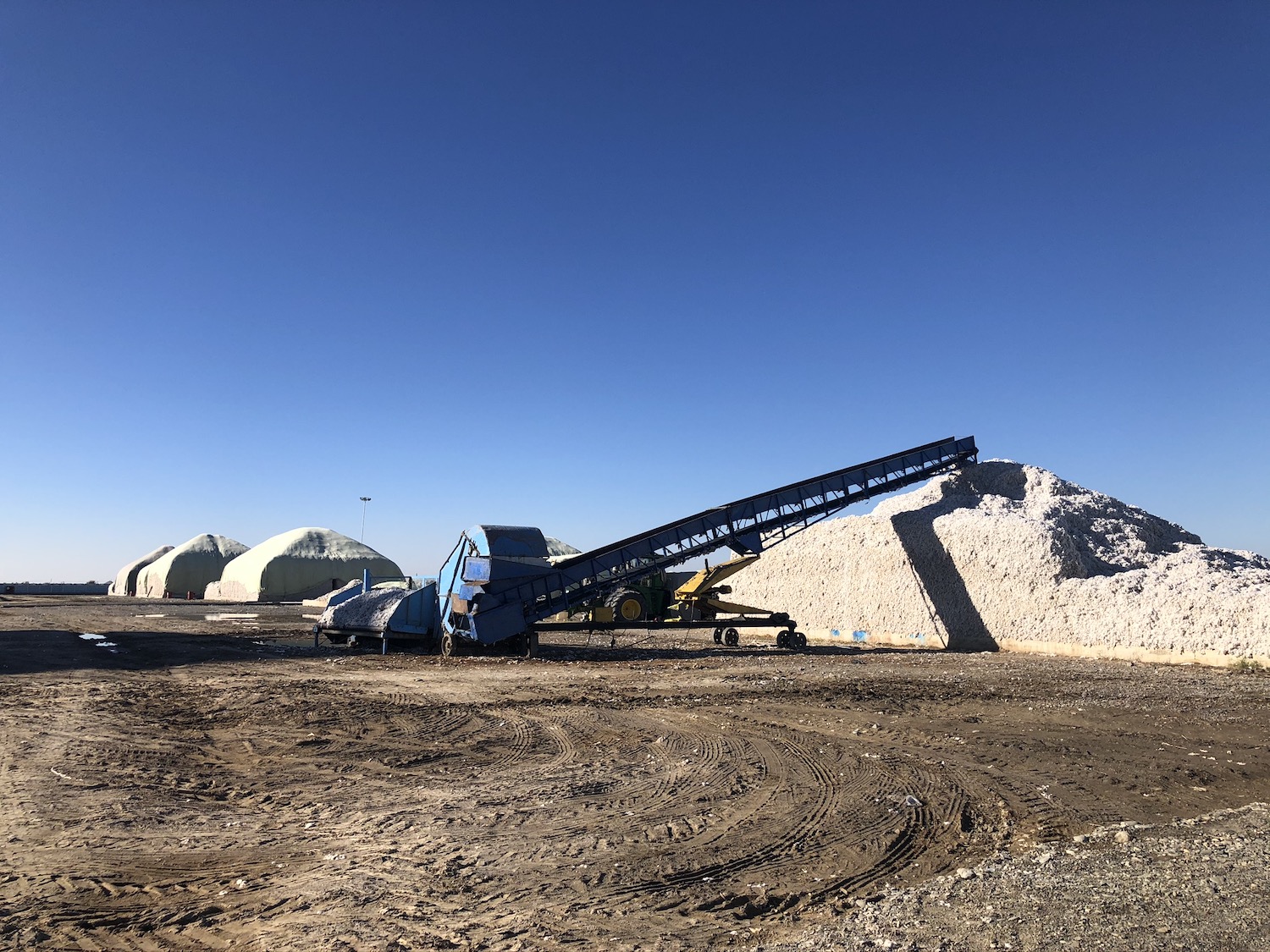
Uzbekistan and the Better Cotton Initiative look to scale more sustainable farming practices
Created with key stakeholders, BCI’s roadmap in Uzbekistan is one of the first large-scale plans to transition the country’s farming practices to a more socially and environmentally sustainable model. It highlights four objectives: developing effective management systems, building stakeholder awareness of environmentally sustainable best practices, creating a three-year strategy for management and delivery, and implementing effective, safe labor systems that manage employer-worker relationships.
Better Cotton’s updated principles and criteria will take effect before the 2024-2025 harvest season, and Uzbekistan adopted it as a target national standard, Katerina Gorbunova, Better Cotton’s Uzbekistan manager, told TriplePundit in an email. The criteria’s six principles include management, natural resources, crop protection, fiber quality, decent work and sustainable livelihoods. Two cross-cutting priorities — gender equality and climate change mitigation and adaptation — shape requirements within these areas.
“From a social standpoint, [the new principles and criteria] will place stronger onus on driving impact and promoting wellbeing in farming communities, supported by more robust requirements surrounding decent work and gender equality,” Gorbunova said. “Through ongoing capacity strengthening and check-ins with farm management and trade unions, in partnership with international and local partners, we will focus on strengthening social dialogue and industrial relations aimed to support workers' representation at the cluster level.”
Accounting for historical context
Clusters, or vertically integrated cotton companies, are a key example of how Uzbekistan's recently privatized cotton industry has changed, and continues to change, on a fundamental structural level from its decades-old Soviet model. The previous model employed state farms — where farmers were effectively state employees — and the smaller-scale, but much more common, collective farms called kolkhoz, Russell Zanca, a professor of anthropology at Northeastern Illinois University, told 3p. The kolkhoz structure persisted even after Uzbekistan’s independence, he said, with farms aiming for district harvest targets instead of quotas within the Soviet five-year plans.
But the kolkhoz were not monolithic. “Collective farms could be successful or very poor based on their leadership, objective conditions in terms of area, soil quality… and the degree to which the state paid attention to that particular area,” Zanca said.
Better Cotton’s principles and criteria account for this kind of variation by identifying three categories of farms — smallholders, medium farms and large farms — based on factors like area, structural dependence on permanent labor, and mechanization. All of BCI’s criteria apply to each of these producer categories, but its measurement of their continuous improvement of sustainable practices takes into account that different farms "start at very different baselines." At this point, the initiative's network in Uzbekistan works with large farms.
Cotton farming’s environmental impact
The roadmap is also poised to shift cotton farming’s ecological and environmental impact in Uzbekistan. Some of the primary harmful farming conditions include soil degradation, water supply, pollutants and pesticides, Zanca said.
The Aral Sea, now the Aralkum desert, was the primary 20th-century water source for Uzbekistan’s largely arid land. Salinization, or salty water, affects 63.5 percent of the country’s irrigated land, according to the International Water Management Institute. Outdated irrigation systems are the main cause, and farmers often add more water to the affected land to leach the salt, further straining the water supply. The Aral seabed now poses public health concerns. Its dust carries to surrounding regions and contains not only salt but also fertilizer and pesticide residue, according to the Convention on Biodiversity.
The new criteria’s environmental impact aims include minimizing damage from crop protection, water stewardship, protecting soil health and supporting biodiversity. “A holistic approach to regenerative agriculture supports resilience and builds and nourishes ecosystems,” Gorbunova said. “Many Uzbekistan cotton producers are already incorporating a number of regenerative agriculture practices focused on soil health, biodiversity, the reduction of synthetic inputs, and improved water efficiency.”
Better Cotton’s Roadmap in Uzbekistan has the potential to be a major driving force in shaping more sustainable farming practices — economically, environmentally and socially. When asked about addressing the country’s main agricultural roadblocks, Zanca’s answer felt globally applicable.
“Most people would fall back on the hackneyed, ‘Oh, it's corruption,’” he said. “That, to a degree, is true. But more than that, [we need] accountability — people being informed about what their chances are to increase their income or prosperity if they practice certain measures, or if they change the way they work a little bit.”
Image credit: Helene Bohyn/Better Cotton
There is No Singular Solution for DEI Cuts: So, Now What?


DEI cuts will cost companies more in the long term and make them less able to attract and retain top talent. (Image credit: fauxels/Pexels)
It's been a bad year for diversity, equity and inclusion (DEI). Budget cuts and layoffs hit corporate and academic DEI departments hard in 2022. The trend backward comes on the heels of rapid growth in the years prior. And while cuts may be one way for companies to tighten their belts as post-pandemic sales drop, future repercussions will likely bring regret.
Short-term gains, long-term losses
Cuts to DEI may lower overhead in the short term, said Ritu Bhasin, a DEI and leadership expert and the author of “We’ve Got This,” a book about finding belonging. “The problem is that the price tag is greater in the long term.”
Companies face a number of consequences when they focus on immediate cuts to the bottom line instead of valuing diversity and creating environments that are inclusive and supportive of all people. “Creativity and innovation will suffer,” she said. “And they'll be less able to capture market share.”
Bhasin breaks this down to a matter of talent, explaining that the companies making cuts to their DEI programs will be less able to attract and retain skilled workers. With employees feeling less psychological safety in these spaces, attrition will increase, and those that remain may be more cautious about sharing creative solutions.
Diversity’s positive effects on profitability are well-established. And yet, in addition to slashing DEI departments and programming, quite a few companies are unsurprisingly showing a reduction in new hire diversity since the middle of last year.
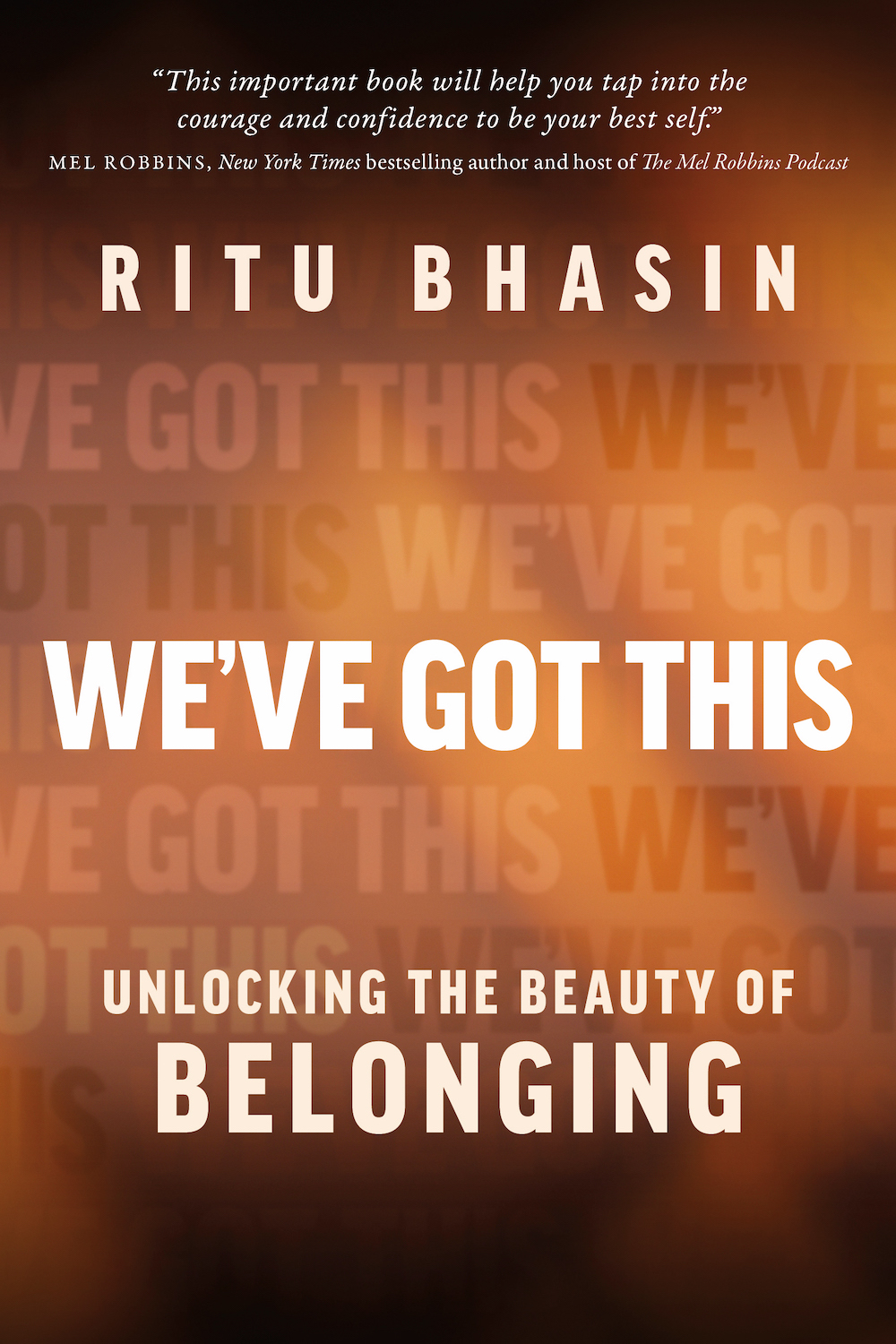
Bucking the trend
Fortunately, not all businesses forget the importance of recruiting people from a variety of backgrounds and aligning workplaces accordingly. In particular, consumer-facing businesses are less likely to cut DEI programming, Bhasin said, because they recognize the need to reflect the diversity of their customers.
“Banking isn’t seeing the elimination of DEI either, or it is minimal [in comparison],” she said. This also makes sense, considering that financial institutions serve consumers directly and may have a better understanding of the need to reflect their customer base.
But for industries making the biggest cuts, choosing short-term monetary profit over long-term effects “reflects an overarching underestimate of the importance of DEI,” Bhasin said. “And it demonstrates that it was a performative commitment to begin with.”
What are the solutions to widespread cuts in DEI?
So, what can be done about it? “It’s a tricky, challenging problem,” she said. “The DEI leaders who helped to grow understanding of the need are being cut. Those who raised awareness are being let go.”

Bhasin doubts employers can be counted on to see the light. “They’re the decision-makers. Who is going to convince them?” she said, noting that perhaps the DEI team or other executives can try. Additionally, employees could choose to leave or become increasingly vocal. “But that’s deeply problematic,” Bhasin said. “It puts the responsibility for change on the community that is being affected.”
She recommends a multi-pronged approach, in which shareholders, clients and consumers hold companies accountable. Depending on the type of business, some groups may have more power than others. With companies that don’t deal directly with the public, it may be up to shareholders, clients and contractors to speak up.
For those that provide consumer products and services, “we can vote by where we spend our money,” Bhasin said. “Stop consuming.” One example of this is Twitter, which has notoriously lost both users and advertisers since billionaire Elon Musk took over at the end of October 2022.
Twitter’s DEI team was decimated upon Musk’s acquisition — reportedly shrinking from 30 positions to just two. And while that is not the only reason for the drastic drop in Twitter advertising, it certainly has a huge impact. The social media site lost nearly half of its marketing revenue as it became a bastion for brazen biases and vehement hatred.
But for all the talk of waning sales and falling profits, overall, corporations are still raking in the dough. While corporate windfalls have not continued at the rate they did in 2021, they remain astronomical when taken into long-term historical context. As such, cuts to DEI program budgets and staff are not only unnecessary, but they are also incredibly unwise. It will ultimately take all of us to set things right.
Images courtesy of Ritu Bhasin
Vodka Martinis Go Green: Distillery 98 is a Trendsetter for Sustainable Spirits


Who doesn’t love an excuse for an espresso martini, Moscow mule or cosmopolitan? Luckily you can have your sustainable cocktail and drink it, too. In the sun-drenched stretches of the Florida panhandle, Distillery 98 produces small-batch vodka with a healthy pour of environmental responsibility.
Co-founders Harrison Holditch and David Kapitanoff pride themselves on using local ingredients and minimizing their environmental impact. “It was just a hobby turned into a profession,” Holditch told TriplePundit. “It’s kind of a long road that took us here, but this is definitely where we belong. The goal is not only to provide a great-tasting vodka, but to do that sustainably.”
As it turns out, they may be onto something.
The footprint of the vodka industry
At first glance, vodka — which is typically made from grains or vegetables — appears to have a low carbon footprint. While that’s true for a single bottle, the footprint of America’s annual vodka consumption is large, equivalent to burning 2.74 billion to 2.96 billion pounds of coal. Most of that carbon footprint comes from manufacturing glass bottles and the energy-intensive distillation process.
Distilleries also produce a lot of wastewater, 12 times more than they do alcohol, according to a 2020 study. Unfortunately, this waste is difficult to dispose of since it’s highly acidic and contains a lot of organic matter.
The makings of sustainable vodka
Distillery 98 is tackling these challenges head-on. “Our new cardboard bottles have six times less of a carbon footprint than a glass bottle,” Holditch said as an example. “A lot of glass right now is coming from India and China. Not only is the carbon footprint massive when it comes to manufacturing these bottles, but shipping them over here adds to that. That’s a big reason we switched to our paper bottle.”
Distillery 98's recycled paperboard bottles by Frugalpac are lighter than glass and decompose much faster than their glass or plastic counterparts. That’s a good thing since glass breaks down extremely slowly — archaeologists found glass artifacts dating from 1500 B.C., for instance.
“We’re the first spirits in the U.S. with this Frugal bottle,” Holditch said. “But I don’t see that lasting much longer. I think it’s a game-changer for our industry.” Other spirits labels, including Johnnie Walker, have also tried out paper bottles made by other manufacturers.
But the distillery didn’t stop at bottles. It uses sustainable swaps for other vital materials and processes, too. Carbon filters, for example, are necessary to remove impurities but are commonly made of wood or coal. Distillery 98 uses coconut carbon filters instead, a renewable, more environment-friendly option. Temperature control is another important part of the procedure, for which water is typically used to cool equipment. Distillery 98 uses renewable, geothermal energy.
Vodka-making at Distillery 98 is also a local affair: The company uses locally-sourced corn for its vodka and donates the spent grain back to Florida farms as livestock feed. The vodka is filtered through Gulf Coast oyster shells to lower the acidity and give it a smoother taste. And in the tasting room, one bartender makes pecan liqueur on his own farm and blends it into his espresso martinis — a great excuse for one if I ever heard it.
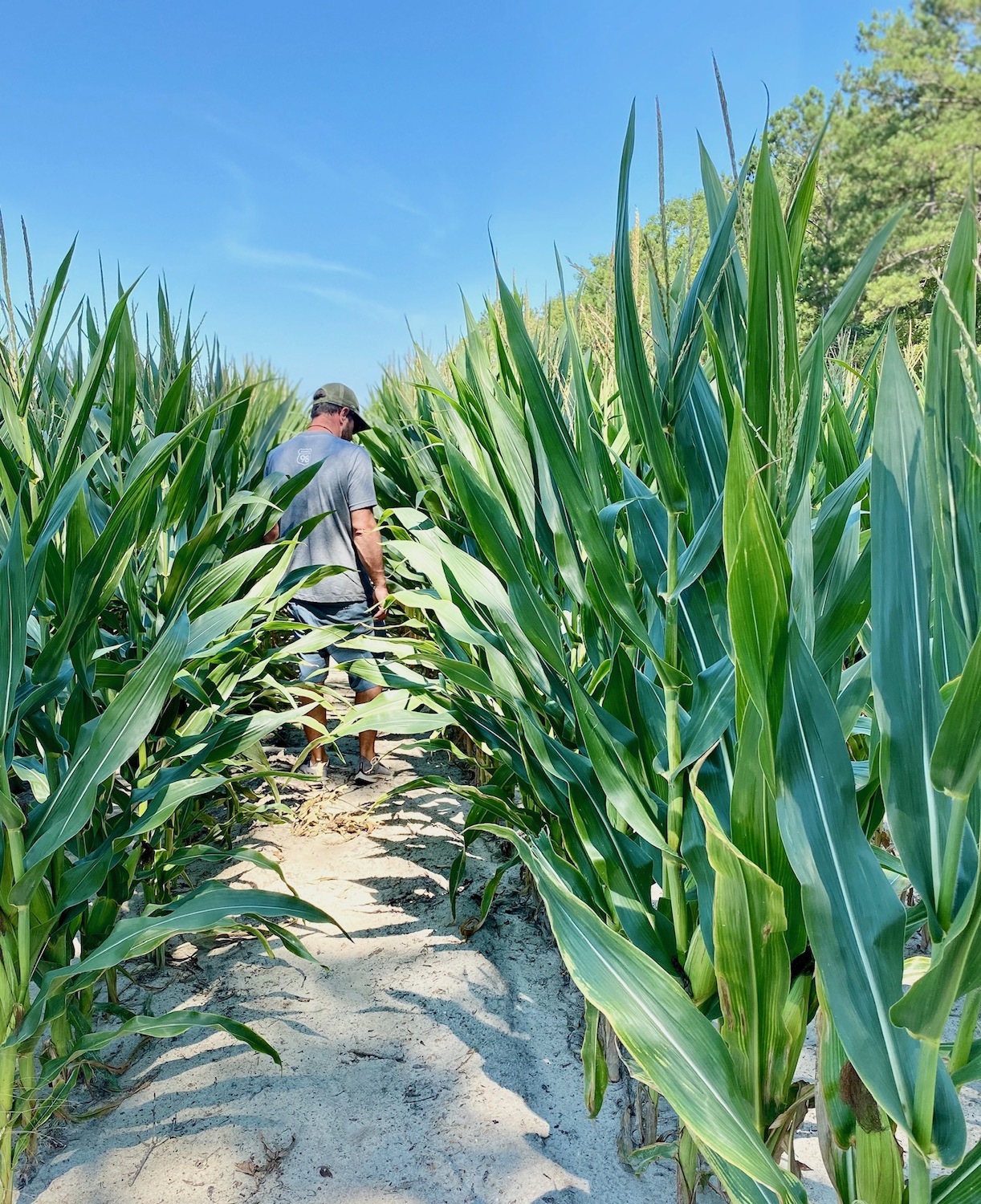
The distillery also sponsors recycling days and cleanup days on the dune lakes in its home base of Santa Rosa Beach and surrounding communities in the Florida Panhandle.
Encouraged by the progress to date, the company plans to expand its sustainable practices. “We’re looking to upgrade our equipment at the distillery,” Holditch said. “Some of the things we’re talking about is bringing in a [desalination] machine. We’re going to treat the water before it goes in our stills and then clean it and continue to use it all in-house. We’re working on getting everything run by solar panels, as well. Now that we’re upgrading, we can really focus on building a green system from ground zero.”
The future of vodka is green
All this laborious effort is worth it. The global vodka industry was valued at over $42 billion last year and is expected to grow to $56 billion by 2027, according to data analysis company Statista. Americans have been steadily sipping more of it over the last two decades, especially flavored vodkas.
Sustainable brands may be poised to take a larger slice of this vodka pie. Consumers, particularly Gen Zers, prefer to buy from sustainable brands. They’re also willing to pay more for products that are environmentally-friendly, prioritizing this over brand name. Young people’s focus on sustainability extends to investing as well, with the majority of them planning on, or already engaged in, socially responsible and impact investments.
A cadre of sustainable distilleries
Distillery 98 joins a growing group of spirits companies heeding the siren call of sustainability, from legacy brands like Kahlúa and Mount Gay Rum to newcomers like Dulce Vida Tequila. These companies are using organic and locally-sourced ingredients, creating reusable bottles and using production waste for fertilizer. They’re also embracing sustainable farming practices and solar energy and powering their facilities with methane gas emitted from operations.
So, next time you’re whipping up an espresso martini, make sure to use liquor brands that are doing their part for a sustainable future. Or just try the pecan one a Distillery 98, it sounds delicious.
Images courtesy of Distillery 98
Farmers Look to Social Media for Help After Vermont Floods


Morgan Gold (right) and Allison Ebrahimi Gold on their farm in Peacham, Vermont.
When recent floods in Vermont broke rainfall records, one farmer used his social media platform to fund emergency disaster grants for neighbors whose crops were destroyed.
As weather patterns become more volatile, the risk for crop loss in the agricultural sector grows. Specialty crop farms — which include small- and mid-sized fruit, vegetable, flower and pastured livestock farms — are in an especially vulnerable position because protections like crop insurance are inaccessible to them.
Morgan Gold owns and operates a duck, goose, cattle and tree farm in northern Vermont called Gold Shaw Farm. He and his wife started farming in 2017 with no prior experience in agriculture, so Gold decided to document their experience of starting a farm on YouTube. His account quickly took off. Today, he has about 4.5 million followers across YouTube, Facebook, Instagram and TikTok.
After the massive flooding in Vermont wreaked havoc on farms across the state last month, Gold hosted a 24-hour livestream to raise funds for the Northeast Organic Farming Association of Vermont (NOFA), an agency that distributes disaster relief funds to farmers.
“Our farm was very lucky,” he said. “We lost 14 or 16 ducklings that lived on pasture with their mothers. But I felt incredibly lucky because friends in the next town over had pastures completely flooded. Market gardeners had their fields wiped out. Because I was lucky and I have a platform, I knew I needed to do something.”

The power of social media
The livestream was broadcast on YouTube and Facebook and featured call-in guests including friends, supporters, subscribers and Vermont's secretary of agriculture, Anson Tebbetts. “I set up webcams around the farm, and I would take my phone with me when I went to pasture to move cattle,” Gold said. “I produced the event while I was on screen.”
Gold encouraged viewers to donate to NOFA Vermont’s Farmer Emergency Fund. “This fund has been established for years, and it seemed the easiest and most direct way to get dollars into the hands of farmers who are in need,” he said.
The stream had over 80,000 viewers and raised $22,000 for the fund with contributions from people all over the world. Gold incentivized donations with creative special offers, such as a live reading of his new children’s book, “Toby Dog of Gold Shaw Farm,” inspired by (you guessed it) the farm's faithful dog. This combination of community engagement, entertainment and incentive drove the success of the fundraising efforts, Gold said.
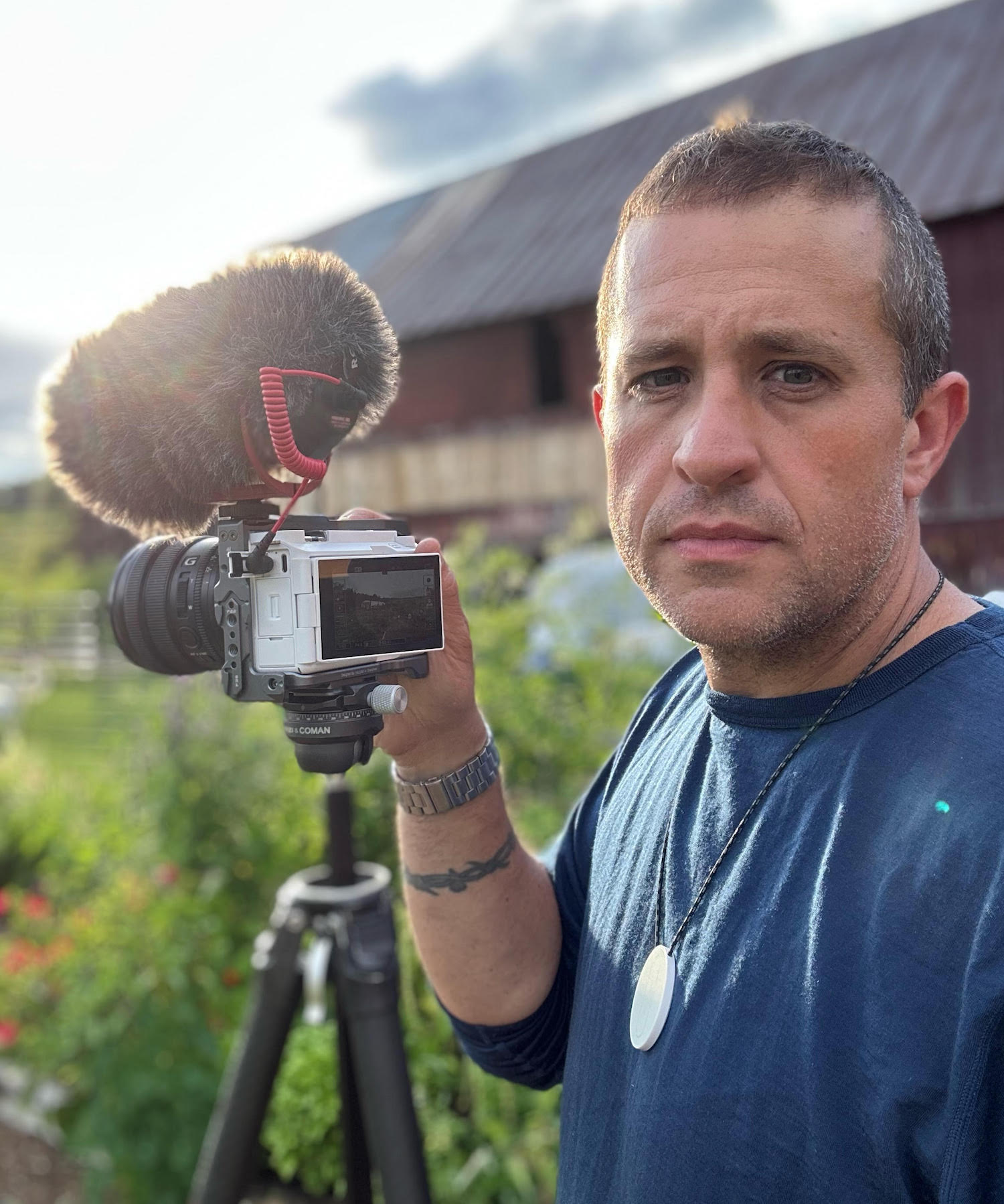
Small farms can't rely on insurance
NOFA Vermont’s emergency fund is critical for many small- and mid-size farmers in the state, as crop insurance is often not accessible or affordable for specialty crop farms.
“There is a broad perception by the public that when a disaster hits, farmers will get paid out,” Gold said. “The perception is misguided ... When you are in an area like ours, flood insurance isn’t common, and business owner protection is not going to be covered for an event like this. Farmers aren't carrying some magic insurance that covers this, and USDA is not going to come and give everyone a check. Commodity farmers might be in a different camp, but smaller, more diversified farms have a harder path for recouping losses.”
Losses from this summer’s floods were especially difficult for Vermont farmers because mid-summer is typically when sales peak, and money earned in the summer months is critical for supporting their operations year-round.
Reflecting on his ability to raise money for other farmers with his platform, Gold said crowdfunding can help in a crisis, but relying on the financial support of social media viewers is not a viable long-term strategy for funding ongoing operations.
Still, he encourages all farmers to think about their digital strategy. “Building an audience on social media helps build broader relationships, and that’s where real opportunities come in.”
Images courtesy of Morgan Gold
Allbirds Made a Net-Zero Shoe and Wants Other Brands to Copy It


The world’s first net-zero shoe is here. Allbirds' recently unveiled high-top shoe, called M0.0NSHOT, is slated for commercial release next spring. Urging others to follow its lead, the cult favorite footwear and apparel brand released all of the information necessary for companies to create their own net-zero shoes — from design to manufacturing to carbon measurement. And the recipe doesn’t rely on purchasing carbon offsets.
“You would normally think a company brings in a new material to their products and they want keep it safe because it's proprietary,” Aileen Lerch, Allbirds’ senior sustainability officer, told TriplePundit. “But in the case of a lot of these solutions, especially to climate change, we actually need an industry-wide adoption for this to become a scalable solution [and] for costs to come down.”
The path to a net-zero shoe
The M0.0NSHOT net-zero shoe isn't Allbirds first foray into climate action and low-carbon materials. The company first created SweetFoam, a midsole foam made from carbon-negative, sugarcane-derived bioplastic, back in 2018. Its latest iteration of the material is used in the midsole of the new M0.0NSHOT shoe.
Allbirds also became the first fashion brand to label products with carbon footprints in 2020. It then partnered with Adidas to make what was the lowest-carbon shoe in the world at the time, the Adizero x Allbirds, before it began developing M0.0NSHOT.
“It’s rare in the footwear industry for two brands to come together and create a shoe. You almost never see it,” Lerch said. “It was this moment that we really recognized, ‘Hey, we’re running the wrong race here. It’s not about us versus them, or two footwear companies competing against each other. We’re all trying to do the same thing and decarbonize our businesses.”
The design
The M0.0NSHOT shoe uses carbon-negative, regenerative wool sourced from Lake Hawea Station, a sustainable sheep and beef farm in New Zealand that sequesters more carbon than it emits. Along with the new sugarcane midsole foam, it's also made with methane-capture bioplastic via a partnership with Mango Materials and sugarcane-based polyethylene packaging, another carbon-negative material that reduces the weight and space required for transportation.
“We didn’t just make the world’s first net-zero carbon shoe. We also made the second, third, fourth net-zero carbon shoe, and so on, as we explored different prototypes to create an appropriate visual identity for this milestone,” Jamie McLellan, design lead on the project, said in a statement. “As we thought about this ‘shoe of the future,’ we were clear that M0.0NSHOT couldn’t look like something from the past. We’ve not just reimagined the science of a sustainable shoe, we’ve reimagined the design, too.”

Will the footwear industry follow suit?
But Allbirds isn’t stopping at creating a net-zero shoe. The company is looking at what it calls the “five lifecycle areas” of the M0.0NSHOT shoe, which include the energy required to manufacture it, the energy used in transportation, the emissions associated with disposal, and emissions created during use — particularly those associated with washing the shoe.
“Our goal for a lot of these actions is: How do we scale it across our business and scale it across our industry?” Lerch said. “That was a lesson that we applied for this shoe, and we’re excited to keep scaling as we work toward a commitment to have 100 percent renewable energy at our tier-one factories and final assembly factories by 2025.”
Most of Allbirds’ shoes are manufactured in Vietnam, which Lerch said is “quite an interesting place” right now for brands who are advocating for renewable energy. The country’s new national energy plan looks to increase much-needed power generation and shift away from coal, but still relies on gas in combination with renewable energy. The company joined other brands and factories in signing a letter encouraging Vietnam’s energy utilities to integrate renewable energy into the power grid.
Open-sourcing the M0.0NSHOT shoe is crucial to moving the footwear industry to reduce its carbon footprint, Lerch said.
“If there was just one granola bar company labeling calories, you wouldn’t actually understand it. You need everyone to do it,” she said. “We saw that we couldn’t just stop at the product. It’s about democratizing and scaling the solutions because these are problems that are not just specific to Allbirds. We all need to be taking collective action to mitigate and reduce the impacts of climate change.”
Images courtesy of Allbirds
Powerful Ways Everyday People Can Counter 'Anti-ESG' Campaigns That Target Sustainable Investing


An estimated 7.6 million young people have taken part in Fridays for Future protests in support of climate action, like this 2019 demonstration in Zürich, Switzerland. But protesting isn't the only way for people to make their voices heard.
The anti-ESG movement, led primarily by a small set of right-wing politicians and pundits, continues to target the use of environmental, social and governance factors in investing. The pushback against ESG and "woke capitalism" is set to be central in the next U.S. presidential election cycle, with critics ramping up the discourse in advance.
Still, the public appears uninspired by the far-right's latest bogeyman, with only about 35 percent of U.S. voters viewing "woke ideologies as a 'major threat' or a 'very important' issue when thinking about their 2024 vote," according to July polling from Morning Consult.
Those growing tired of the anti-ESG discourse don't have to resign to simply tuning it out. We spoke with Andrew Behar, CEO of As You Sow, a nonprofit foundation that promotes shareholder advocacy, about powerful ways everyday people can voice what they really think about ESG and the shift toward more sustainable and socially responsible ways of doing business.
Take action: Counter anti-ESG narratives by learning and sharing
The much ado about anti-ESG may not have the effect critics intended. While the majority of the public remains ambivalent, anti-ESG criticism has also sparked new conversations where there were none before. "The good news is there are tens of millions of people who'd never heard of ESG who now have heard of it. They'd never heard of sustainable investing — they didn't know you could invest sustainably," Behar said. "Now they're aware their investing has an impact. And actually a lot more people are coming to ESG investing because of it. I think it's really backfiring."
Still, anti-ESG narratives can create confusion about what ESG criteria are actually meant to do. Last year, As You Sow launched the AmplifyESG content library to counter the misinformation about ESG online. It's curated by an editorial review board that includes representatives from business and both U.S. political parties, Behar said.
Hosted on Hootsuite, the library is updated at least a few times a week with articles, quotes, videos and other resources about ESG, which users can easily share across their social media platforms as they choose. Shares from AmplifyESG have reached nearly 3 million people over the past year, and anyone can get involved in driving more evidence-based conversations about ESG in business.
Take action: Leverage your right to vote
No, we don't mean at the ballot box. Of course that's important, too, but in this case we're talking about the proxy voting rights afforded to everyone who owns shares in a publicly-traded company. "If you're an individual who has bought shares on E-Trade or Schwab or Robinhood or whatever, you have the right to vote — even if you own just one share," Behar said. "And that vote is very, very important."
An estimated 25 percent of all shareholders do not exercise their proxy votes, he explained. "If those 25 percent decided to get off the bleachers and get on the playing field, that makes a big difference. That makes the difference between a majority vote or one that's just under the majority line."
But exercising the right to vote by proxy is traditionally not a user-friendly process for individual shareholders. "It's always been difficult," Behar said. "Generally you get an email that says, ‘Time to vote.’ But when you look at the ballot, there's 20 or 30 decisions to make. Who's on the board? How much do the executives get paid? Who's the auditor? What about all these shareholder resolutions? It's very complex."
As You Sow has published annual proxy guidelines for decades, outlining votes they deem to be aligned with ESG principles. Three years ago, it automated the process by embedding its guidelines into Broadridge Financial Solutions' ProxyEdge platform for institutional investors. The paid service allows institutions like asset managers, endowments and foundations to vote in an ESG-aligned way in only a few clicks. They can also customize their votes from As You Sow's defaults as they choose.
This year, As You Sow went a step further with a free service for individual investors at AsYouVote.org. "You can now redirect that email so we will automatically fill in the ballot," Behar said. "It'll all be filled out in an ESG-aligned way, and you can make adjustments."
This simple shift allows individual shareholders to move from being overwhelmed by proxy voting emails to automating the process of voting with their values, with the option to customize if they'd like. "I think a lot of people feel guilty. They see all these proxy statements piling up in their inbox and they think, 'I just can't deal with it.' What you'll get instead is, 'Thanks for voting.' You'll feel great about yourself, and it takes literally two minutes to set up."
Take action: How mutual fund and 401(k) investors can make their voices heard
Traditionally, people who invest in funds rather than individual stocks have a much harder time making their voices heard come proxy season, but this is beginning to change thanks to new technology.
"If you own shares in a mutual fund, you have the right to vote. Right now, you have abdicated that right to Vanguard or BlackRock or State Street or whoever, and they're voting on your behalf. They're probably not voting the way you like," Behar said. "You might want to vote for a livable planet. You can demand that. You can say, 'I want that vote,' and they will give it to you. It's very new. The technology is just unfolding."
Technology advancements mean that individual mutual fund investors can vote their own proxies, with the fund manager voting in alignment with the aggregated results at a company's annual shareholders meeting. This is known as pass-through voting.
In April, As You Sow linked up with the proxy technology company Iconik to make this option available to investors in an S&P 500 mutual fund. Hundreds of investors have already taken advantage of it, Behar said, with more funds on the horizon. "We're now in conversations with every other proxy voting service," he said. Broadridge Financial Solutions, a major tech provider for institutional investors, is among those working with fund managers to make this option available to their customers. Get in touch with your fund manager to see what options you have.
Similarly, those who invest in 401(k) plans through their employers also have the right to vote by proxy, but they need to reclaim it from the fund managers associated with their plans. "If you're in a 401(k) plan — where you probably own a target date fund, which is a fund of funds — you're going to need to go to your plan administrator and say, 'I want to vote.'"
If employees band together to ask for their vote, the employer can decide to work with the fund manager to make the option available. As You Sow is in talks with employee-organized groups at companies including Google and Microsoft, who want to leverage the voting power associated with their 401(k)s.
The bottom line: You have more power than you think
Counter to the anti-ESG narrative, most people want to see business operate sustainably, with 99 percent of millennial investors, 82 percent of women and 72 percent of people overall saying they would choose to vote their proxies with sustainability in mind, according to polling from As You Sow.
"We know we've got this vast majority of folks who actually want to vote to get corporations to provide a livable planet," Behar said. "It's a matter now of just getting people to talk about it and say, ‘Okay, I'll do that. I'll click that.'"
Where market forces are already driving business closer to ESG principles, everyday people realizing and claiming the power they hold could open the floodgates.
"People abdicate their power. The way people give away their private personal information to Facebook, they abdicate the power of their money to Vanguard, State Street and BlackRock. It's amazing. People give away all their power and all their information for nothing," Behar said. "We have a culture where people look at things like climate change and think, ‘There’s nothing I can do.’ No. You have so much power. You just choose not to use it."
Image credit: Tom Seger/Unsplash